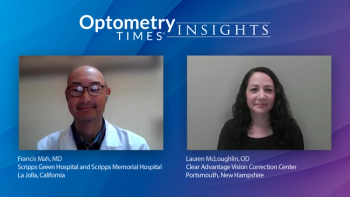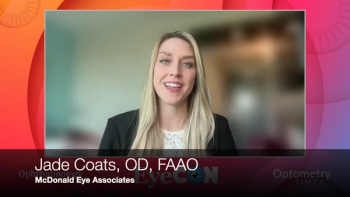
What's Your WhEYE? A conversation with Ali Tafreshi, CEO and president of Topcon
The intersection of artificial intelligence (AI) and eye care is transforming the way health care is delivered, with potential far beyond traditional optometry and ophthalmology. Peg Achenbach, OD, FAAO, executive director of global ambassador strategies, ophthalmology and optometry, for Optometry Times, recently sat down with Ali Tafreshi, CEO and president of Topcon Healthcare, based in Oakland, New Jersey, for a conversation as part of the What’s Your WhEYE? interview program.
Together, they dig into Tafreshi’s driving force, the role of AI in eye care, and AI’s implications for the broader health care landscape. Their conversation explores Tafreshi’s personal journey, the science of ocular biomarkers, and the integration of AI into a connected care system.
A personal journey to innovation
Tafreshi’s passion for medicine was sparked during childhood when he frequently fell ill and found comfort in the care of his physician uncle. This early exposure motivated him to pursue a career in health care. As an undergraduate, Tafreshi explored various medical disciplines before serendipitously landing in the glaucoma research department at UC San Diego in California. There, he encountered advanced imaging technologies capable of generating 3D maps of the eye. With a background in math and physics, he was captivated by the ability to derive quantitative insights from ocular images.
His research expanded into imaging patients with Parkinson and Alzheimer diseases, where he observed that ocular changes could serve as early indicators of systemic and neurological conditions. This realization set him on a mission—not to become a physician but to bridge the gap between cutting-edge technology and patient care.
The science behind ocular biomarkers
The eye provides a unique window into overall health, as changes in ocular structures can reflect systemic conditions. The concept of “ocular biomarkers” has existed for some time, but the explosion of AI technology has made real-time analysis and clinical application possible. Tafreshi emphasized that advancements in AI have increased the sensitivity and specificity of ocular imaging, allowing providers to detect early signs of diseases such as diabetes, cardiovascular disease, and neurodegenerative disorders.
Topcon Healthcare’s “Healthcare from the Eye” initiative is designed to integrate ocular biomarkers into a connected care system. The goal is to move beyond mere detection—creating a seamless pathway for patient triage, referral, and intervention. Tafreshi highlighted the importance of leveraging AI for diagnostics and ensuring patients are directed to the appropriate specialists.
To achieve this, the initiative seeks to do the following:
- Enhance collaboration between eye care professionals, primary care providers, and specialists.
- Utilize AI-powered imaging to identify systemic health risks through routine eye examinations.
- Expand access to care by deploying automated, robotic imaging devices in nontraditional health care settings, such as pharmacies and retail locations.
- Implement a cloud-based platform to facilitate secure data sharing and streamlined patient management.
Bringing eye care to underserved populations
A critical aspect of this initiative is its potential to improve health equity. Many rural and underserved communities lack access to specialized health care, making early detection of chronic diseases difficult. Tafreshi and his team aim to place AI-powered imaging devices in easily accessible locations, ensuring that patients in remote areas receive timely screenings. He referenced an ongoing partnership with the University of Texas at Tyler to deploy this technology in eastern Texas, where high morbidity rates and health care access challenges persist.
Overcoming barriers to adoption
Despite the promise of AI in eye care, there are significant hurdles to widespread implementation. Tafreshi identified key challenges as follows:
- Regulatory and policy considerations: Ensuring AI-driven diagnostics meet stringent regulatory standards and gain approval from organizations such as the FDA
- Provider adoption and trust: Educating optometrists, ophthalmologists, and other health care professionals about the accuracy and reliability of AI-driven diagnostics
- Patient engagement: Building trust in AI-generated results and demonstrating the benefits of early detection
The role of AI in a collaborative health care system
Tafreshi stressed the importance of a collaborative approach to AI-driven health care. Optometrists play a central role in this vision as the gateway for detecting systemic diseases through ocular imaging. He envisions a future where AI-powered diagnostics are integrated across specialties, from cardiology to neurology, enabling a holistic approach to patient care.
To facilitate this, Topcon Healthcare has established the Alliance for Healthcare from the Eye, bringing together stakeholders from regulatory agencies, insurance providers, academic institutions, and industry leaders. Tafreshi hopes to drive policy changes, improve reimbursement models, and accelerate adoption by aligning these groups.
Addressing AI skepticism in eye care
AI adoption in health care is often met with skepticism from providers and patients. Tafreshi acknowledged these concerns, emphasizing the need for transparency in AI algorithms. For practitioners, understanding how AI models derive their conclusions is crucial for building confidence. Rigorous validation studies and regulatory oversight help ensure reliability.
On the patient side, data security and privacy are paramount. Tafreshi said cloud-based platforms, combined with encryption technologies like blockchain, can provide secure and patient-controlled data storage. He also stressed the importance of patient education, helping individuals understand how AI-driven insights can enhance their health care experience.
A call to action for eye care professionals
As the interview concluded, Tafreshi reiterated his belief that the future of health care hinges on integrating AI into routine clinical practice. He urged optometrists to embrace this technological shift and recognize their role in shaping the next era of medicine.
“Optometry and ophthalmology will become the central hub for health care,” he stated. “We have a responsibility to lead this transformation, ensuring that AI-driven diagnostics improve patient outcomes while maintaining the highest standards of care.”
The road ahead is filled with challenges, but as AI continues to evolve, its potential to revolutionize eye care—and health care as a whole—cannot be overstated. By embracing AI as a tool rather than a replacement, eye care providers can play a crucial role in the future of precision medicine and preventive health care.
Newsletter
Want more insights like this? Subscribe to Optometry Times and get clinical pearls and practice tips delivered straight to your inbox.

















































.png)


